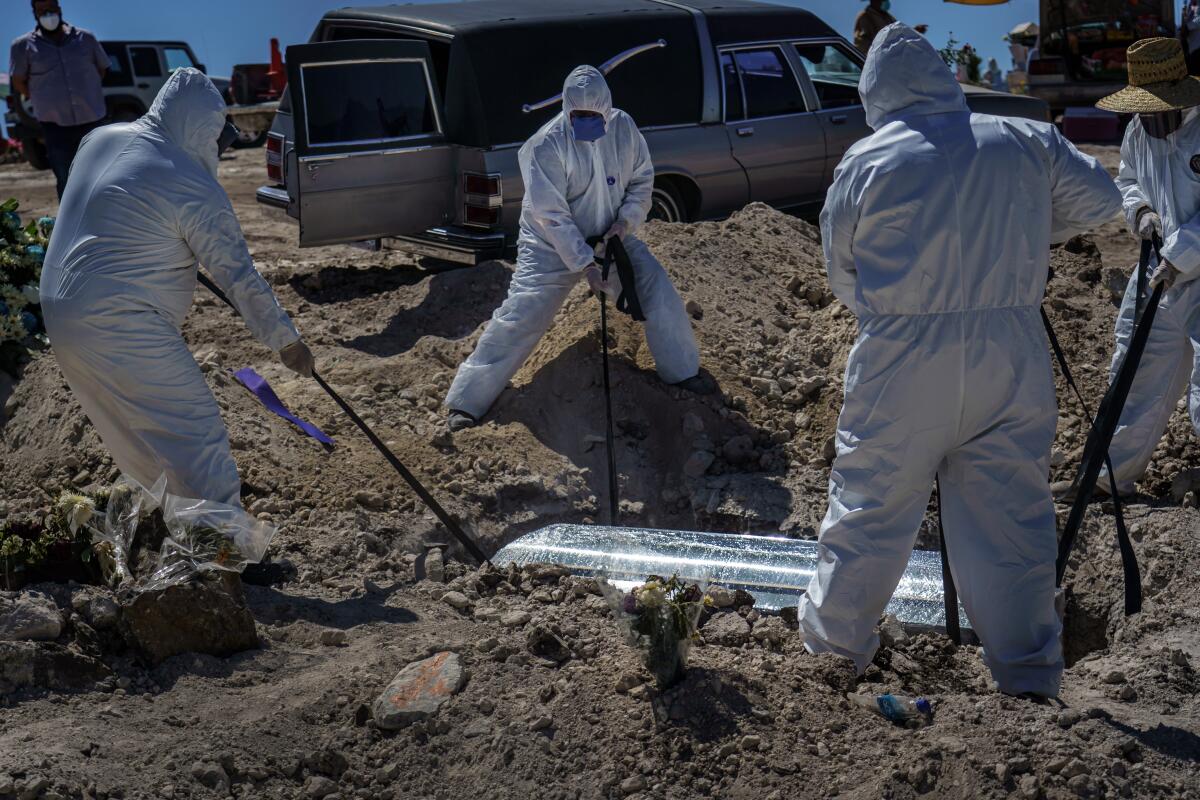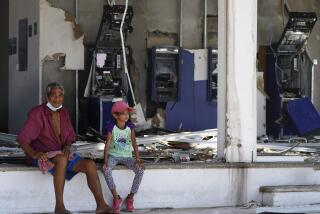Street life slowly returns to Mexico, even as the coronavirus toll climbs

The stream of vehicles bearing flowers and lost lives has not abated, but vendors are back at the gates of the San Mateo Tlaltenango cemetery.
“We were all scared and stayed away when the coronavirus dead first started arriving,” said Victoria Ramírez, who hawks sandwiches, fruit and chips sprinkled with chile and lemon. “But now we see the hearses coming and we say, ‘We are going to have good sales today!’ “
The official death toll in Mexico quietly surpassed 70,000 this month, a figure topped only in the United States, Brazil and India.
For many, the daily recitations of grim statistics have only registered as abstractions.
“It’s terrible that we are normalizing the fact that something like 400 people die every day from COVID-19,” lamented columnist José Sánchez Zolliker on Twitter.
Street life and all its attendant hubbub — crowded buses and trains, packed parks, jammed highways — have been returning gradually to this metropolis of more than 20 million.
Social distancing mandates are often flouted, though masks are the norm. Remote learning remains in place at schools, and large gatherings are still banned.
Both deaths and cases have been on the decline in recent weeks, as have the percentage of positive tests.
But health authorities have warned of potential new outbreaks, especially if people abandon caution, and of possible overlap next month with influenza season.
Hugo López-Gatell, the undersecretary of health who heads the nation’s battle against the virus, has been hesitant to prognosticate since reality intruded on his earlier predictions — that the national death toll would not surpass 8,000, then 35,000, then 60,000, the last of which he termed a “catastrophic” projection.
In terms of the rate of death, Mexico ranks 14th in the world, with 57 fatalities for every 100,000 people, according to Johns Hopkins University.
President Andrés Manuel López Obrador has seized on that statistic to defend his administration from criticism that it has mishandled the response to the virus.
“This pandemic that is battering the whole world is treating us better,” he told reporters this month, noting how “countries with greater economic potency, more medical infrastructure” — including the United States and various European and South American nations — have higher death rates.
As cases began to mount here in March, the president was slow to act. He continued to stage public rallies, encouraged citizens to keep going to restaurants and at one point held up a U.S. $2 bill and a four-leaf clover and suggested that was all the protection he needed.
Alarmed advisors finally convinced him to issue a public pronouncement endorsing a stay-at-home scheme and social distancing. Officials here now credit those strategies — as well as a rapid expansion of hospital beds, ventilators and medical personnel — with averting a catastrophic scenario like the one in Guayaquil, Ecuador, where bodies piled up on the streets.
“The medical system was not overwhelmed,” López Obrador proclaimed.
Unlike many other nations, Mexico never shut its borders, declared a curfew or imposed a nationwide lockdown. Nor did it launch large-scale testing, which many specialists deem essential in assessing the sweep of the virus and implementing contact tracing to contain the spread.
Experts said the official death toll — which includes only confirmed cases — is undoubtedly a significant undercount.
In August, a World Health Organization official declared that the epidemic in Mexico “is clearly underrecognized,” since the country was only conducting about three tests for every 100,000 people — one-fiftieth the rate in the United States.
Experts say the best way to estimate coronavirus fatalities is to look at deaths of all types since the pandemic began and compare that figure with the total number of deaths during the same period in previous years.
In a recently released study of mortality in 24 of Mexico’s 32 states, the health ministry found that between mid-March and Aug. 1, the total number of “excess deaths” was 122,765 — or a surge of 59%, though it is not clear that all of those are from the virus.
With so little testing, many deaths in Mexico are listed as “suspected” COVID-19 fatalities, especially among those who die outside of hospitals.
Cases like that of Consuelo Velázquez are not unusual.
In mid-August, the 73-year-old experienced a sore throat, fever and shortness of breath at her home in Cuautitlán, a working-class suburb of the capital.
“But my mother didn’t want to go to the hospital,” recalled her daughter, Guadalupe Contreras Velázquez, 52. “She said if we took her to the hospital, she would die.”
After her death on Aug. 15, her body remained at the house for two days because the pandemic had caused a nationwide shortage of death certificate forms.
This month, a group of six former national health ministers — all of whom served under administrations now in the opposition camp — urged the government to adopt “massive” testing and enforce more stringent social distancing and mask-wearing.
“We cannot become accustomed to a tragedy of this magnitude in which the numbers lose all meaning,” Julio Frenk, who is now president of the University of Miami, told a virtual conference outlining the proposal.
It would appear, however, that many in Mexico are not in the mood for further restrictions.
The sentiment is common everywhere, but in a country like Mexico, where half the population is poor and many live day to day off the informal economy, the push to reopen the economy is often framed as a question of basic survival.
Economists have projected that Mexico’s net output will fall at least 10% this year, the steepest plunge since the Great Depression.
Rodrigo Alcantara, 43, a minibus driver, said he took a few days off in the spring as the virus devastated his neighborhood in Iztapalapa, a densely populated district that has the highest concentration of coronavirus cases in the capital.
But he is now back to guiding his green-and-white minibus through the busy streets, as the number of passengers has steadily increased.
“One has to become accustomed to live with the coronavirus — you can’t spend all your life shut inside,” he said as he waited at a bus stop to begin his 12-hour shift. “One can’t live all the time in fear of an illness.”
McDonnell is a Times staff writer. Sánchez a special correspondent.
More to Read
Start your day right
Sign up for Essential California for news, features and recommendations from the L.A. Times and beyond in your inbox six days a week.
You may occasionally receive promotional content from the Los Angeles Times.





